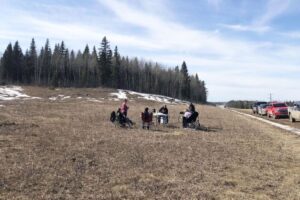By Laura Bohnert
The Alberta budget was announced by Finance Minister Joe Ceci earlier this month, but despite the role the carbon levy is expected to play in the generation of $5.4 billion that will be put towards Alberta’s growing deficit, no mention was made of the carbon tax during the speech. Is this an ill omen for the still-controversial levy?
Interim PC leader Ric McIver seems to think so, arguing that the absence of carbon pricing during the budget speech may suggest that the current government is “backpedaling” from a tax that remains unpopular—one other opposition leaders suggest may not have been priced properly.
But beyond oppositional attempts to stir up controversy that may fuel further dissent toward the NDP, how is the carbon tax working out?
Much of the carbon tax criticism points to its inability to effectively resolve the current Alberta budget deficit—but that’s really not what the carbon tax was intended to do. The carbon levy was implemented in order to help low- to middle-income families receive funding that would in turn incentivize (and thus support) investments in green and renewable energy solutions.
Approximately 60 per cent of Albertans are eligible for the full rebate on carbon tax costs while others get a partial rebate. Funding for the rebate comes from 28 per cent of the amount generated by the levy, province-wide.
In other words, 28 per cent of the money generated by the carbon levy goes back to Albertans to help those with smaller budgets both to cover the increase in costs as a result of the levy, but also to help encourage those same families—families who otherwise may not be able to afford the investment—to invest that returned income into renewable energy.
Where does the rest of the carbon levy revenue go? Deeper into the province into areas that will encourage business development, the growth of a green energy industry, and job creation. A further 19 per cent will be used to fund grants to renewable energy companies, green tech developers, and those communities who now need to transition from coal power; and 24 per cent will be dedicated to green infrastructure, spending which includes public transit, etc.
The final percentage of levy revenue goes towards energy efficiency initiatives—LED light bulb upgrades—towards small business tax reductions, to coal phase-out agreements, and finally to Indigenous communities.
It may still be controversial, still working out a few kinks (like the current amendment that now protects grieving families from having to pay back the levy as a result of ineligibility due to the loss of a family member), and it is definitely still being used as a political tactic by opposition leaders who are hoping to get an edge on the NDP government by condemning their new legislation, but the carbon levy may not be as unproductive as the opposition had been hoping—at least that’s how it appears now that the federal government has announced it will be looking to Alberta as a model for a nation-wide carbon tax proram.







More Stories
Rising tariffs, skyrocketing duties and an Albertan forestry industry in need of support at home